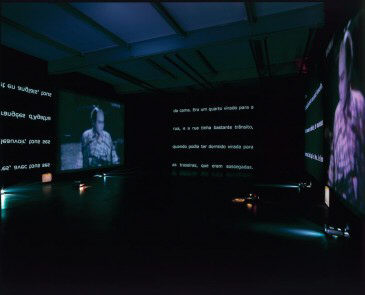
João Penalva
Violette Avéry
Lisbon, 1949
João Penalva began his artistic career as a professional dancer (1968-76), having studied in Lisbon, Paris and London, and joining the companies of Pina Bausch (1973-74), Gerhard Bohner (1975) and another one he formed with Jean Pomares (The Moon Dance Company, 1976). Penalva even worked as a theatre designer, but decided instead to move to London and study visual arts at the Chelsea School of Art, where he finished his BA and MFA (1976-81), with a Calouste Gulbenkian Foundation’s scholarship (1978-80). Painting started taking over the whole of João Penalva’s artistic creation, although not forgoing his former technical training. Indeed, Merce Cunningham’s choreographic method proved to be pictorially decisive, “it was that rational system”, Penalva avowed, “which came to mark the rest of my artistic life.”* Using that anti-narrative conception and the unabashed blending of figurative and abstract languages, his canvases were rhythmically arranged in a variety of decorative elements and geometrical, abstract or calligraphic signs, creating a game of contrasts between colours, textures and patterns, in the characteristic freewheeling of Neo-Expressionist gestualism. These were the paintings shown by Penalva in his first solo exhibitions, at the National Society of Fine Arts (Lisbon, 1983) and at Galeria Roma e Pavia (Porto, 1983).
The 1990s, which started off with a seminal exhibition of Penalva’s painting at the Centre of Modern Art (Lisbon, 1990), brought about a new artistic twist. Considering that, on its own, his painting didn’t achieve the desired narrative complexity and density, Penalva resorted to other artistic languages and practices, retrieving his initial experience with theatre and choreography to explore film, video, text and installation. Since then, João Penalva considers himself, first and foremost, as a “storyteller”, interested in challenging reality with imagination, and committed to construct and deconstruct narrative structures by combining sounds, images and texts (written and oral). All these narrative elements work – as in his painting – by juxtaposition or disjunction, after being arranged in large-scale multimedia installations, or in intimate works with films and slide projections, drawing and painting, whose starting point is to be found in photography, language, theatre, objects or videos – which are, at first, subdued to his installations, but gradually evolve as autonomous products of cinematographic reflection, having become a prevailing medium nowadays.
The visual and literary narratives thus elaborated, assume two distinct trends: either they spring from specific referents of fiction and reality, and dissect the discourses with references taken out of literature and history of art; or else, they spring from places and situations which cannot be identified in space or time, as they were transfigured in ineffable spaces, contemplative fictions, a trend that has been increasingly accentuating in recent years. While the former is born out of an artistic investigation and documental research about the trigger event, gathering documents, memories, reports and stories, and a constant work with found materials, the latter operation delimits a territory where time and space are denied, emphasizing ambiguity and blurriness, in films whose narrator voices are in unexpected languages (Russian, Japanese, Swedish), or in photos where all things mingle in a state of limb, outlining mysterious and nondescript objects. The ambivalence of this work is also evident in João Penalva’s series of artist books that conciliate two poles in tension, either using found images from his eclectic archive, and the photos he took of the movement of clouds and waves.
João Penalva’s work is centred on strategies of visuality – how it is created, transmitted and received. And this is largely reliant upon his intense artistic intervention in the curatorial practices of solo exhibitions, in his clear programmatic decision of interrelating the artworks and making sure that the public is involved performatively, relating to the choreographed disposition of the objects, in the same way that his photos have texts with narratives and characters, which invite the onlooker to associate words and images. It is with such great stress on the hiper-narrativity of his works, that Penalva manages to make the terrains of narrative and fiction overcome the edges of reality.
João Penalva represented Portugal in the XXIII International Biennale of São Paulo (1996) and in the XLIX Venice Biennale (2001). He also exhibited at the I International Biennale of Melbourne (1999), at Berlin Biennale 2 (2001) and at the Sydney Biennale (2002). Penalva was a guest artist of the residence programmes Les Récollets (Paris, 2005) and DAAD (Berlin, 2003-04), and won the Bryan Robertson Award (London, 2009). After a decade of one-man shows ever more regular and far-off in the world, touring in Vilnius, London, Innsbruck, Glasgow, Malmö, Milwaukee, Toronto, Budapest, Berlin, Paris, Munich or Perth, João Penalva’s retrospectives are featured at CAM (2011) and at Brandts Kunsthallen in Odense, Denmark (2012).
* “Diálogo entre João Fernandes e João Penalva” in João Penalva, Porto: Fundação de Serralves, 2005, p. 12.
AR
June 2011